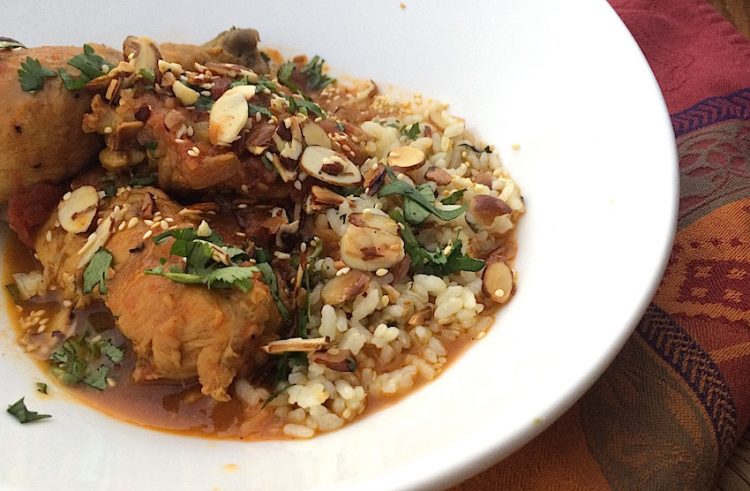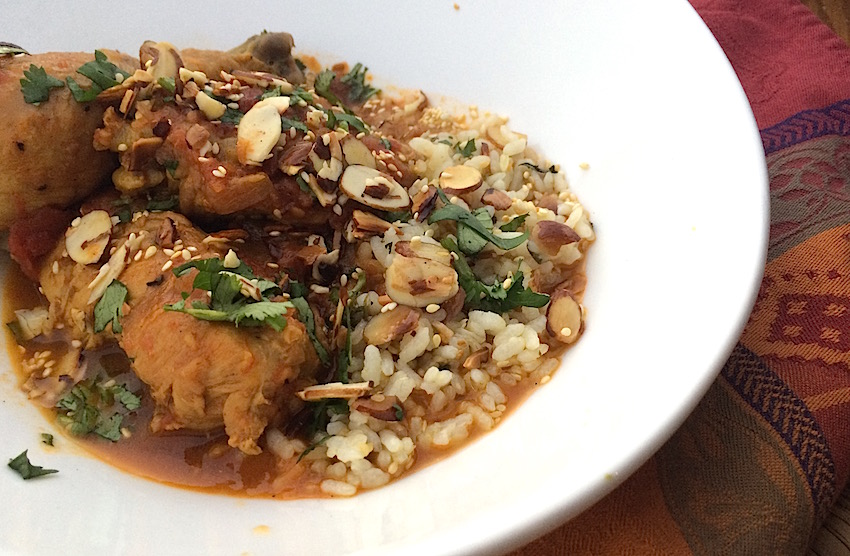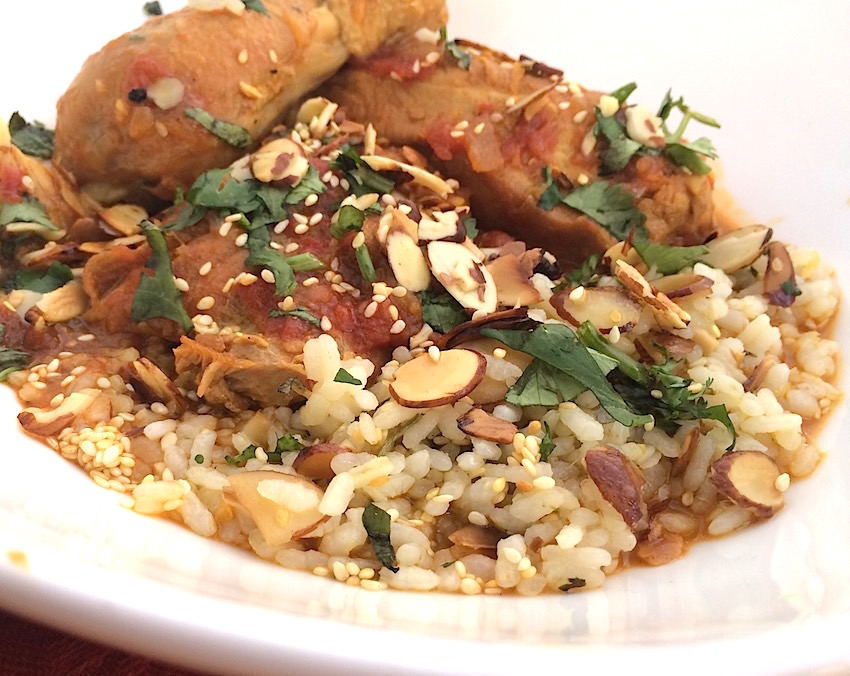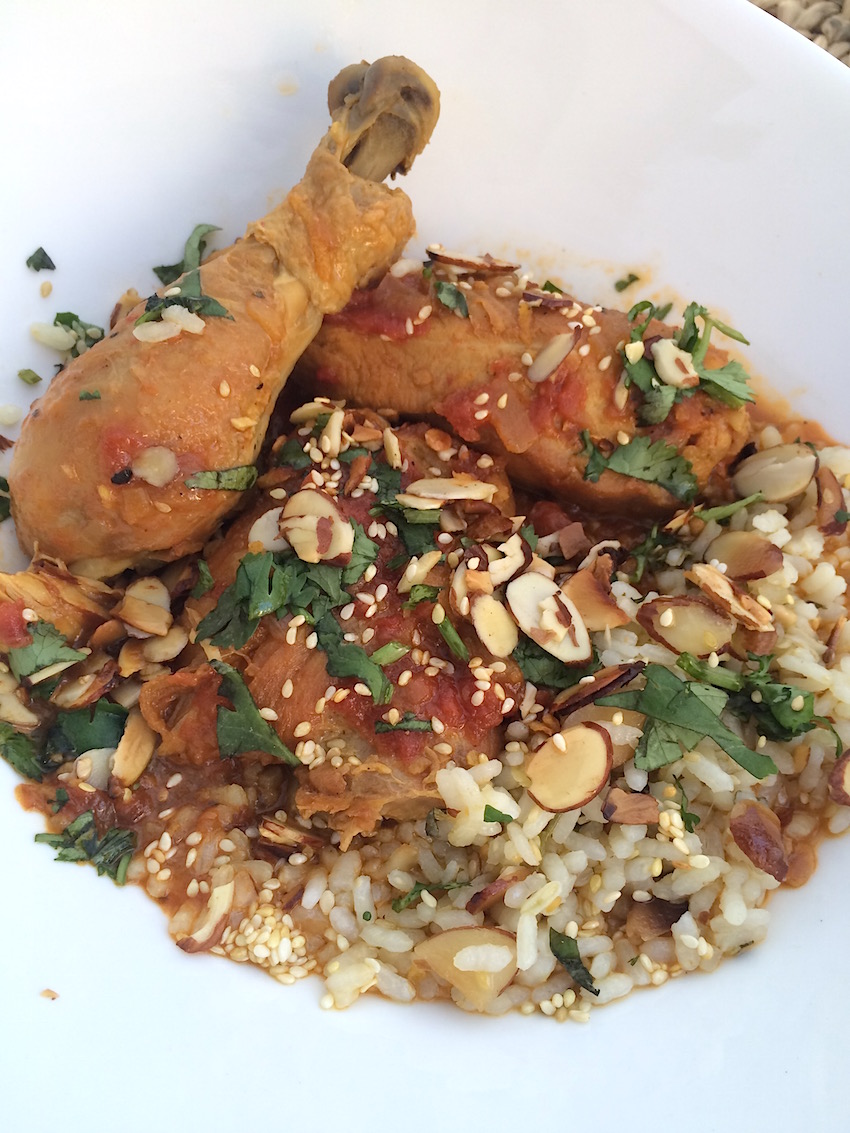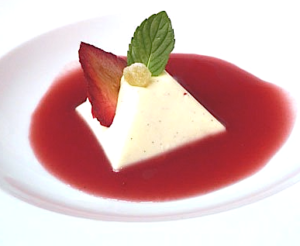This is one tasty dish – definitely worthy of a romantic meal for two, especially in the colder winter months ahead. This recipe caught my eye while perusing the latest and greatest on Pinterest. It’s from a British magazine called Delicious -and this dish truly is. A North African chicken stew made with garlic, ginger, lemon, and cinnamon finished with a kiss of honey and saffron – needless to say, the aroma in your kitchen will be quite seductive. And, the couscous (or rice) is pretty fab and full of flavor on its own. From Delicious magazine: “..This dish needs a fruity, off-dry white wine. Chenin blanc, such as Vouvray from France, or New Zealand riesling”.
North African Chicken Stew with Honey and Saffron / Delicious Magazine (original recipe)
For the Chicken:
- 3 – 4 lb free-range chicken, jointed into 8 pieces
- 3 tbsp olive oil
- 1 large onion, chopped
- 3 garlic cloves, crushed
- 2 inches fresh ginger, finely grated
- 2 x 2 inch cinnamon stick pieces
- 1 tsp ground ginger
- 1 28-oz skinned and chopped tomatoes, fresh or tinned
- 1 tsp harissa paste, rose if you can get it
- 10 oz chicken stock (see Debbie’s tip)
- 1/2 tsp saffron strands
- 2 tbsp clear honey
- 1 tbsp lemon juice
- 1 tsp orange blossom water (see tip below)
For the lemon and mint couscous (or as in this case, rice)
- 1 oz butter, plus 1 oz melted butter
- 1/4 cup slivered or sliced almonds
- 3 tbsp white sesame seeds
- 1 cup organic couscous or rice (I used Bomba rice)
- 1/2 tsp salt
- 2-3 tbsp extra-virgin olive oil
- Finely grated zest of 1 small lemon and 1-2 tbsp juice
- 4 small preserved lemons, pulp discarded, skin finely chopped
- Small bunch of fresh coriander, coarsely chopped
- Small bunch of fresh mint, leaves finely chopped
Directions
- Skin the chicken pieces, then season all over.
- Heat 2 tbsp of the oil in a sauté pan or shallow flameproof casserole. Add the chicken and fry, turning, until browned all over. Lift onto a plate and keep warm.
- Add the rest of the oil and the onion to the pan, then cook over a medium- high heat, stirring, for 6-7 minutes until soft and golden.
- Add the garlic, fresh ginger and cinnamon, then cook for 2-3 minutes more. Add the ground ginger and cook for 1 minute.
- Stir in the tomatoes and harissa and cook gently for 5 minutes.
- Stir in the chicken stock, saffron and some seasoning to taste, then bring to the boil. Return the chicken to the pan, cover and simmer for 25 minutes.
- When the chicken is cooked, lift the pieces onto a plate and cover with cling film to keep moist. Turn up the heat and bubble the sauce briskly for about 10 minutes until reduced by about half.
- Add the honey, simmer for 2 minutes more, then stir in the lemon juice and orange blossom water. Taste and season.
- Meanwhile, for the couscous, melt the 1 tsp butter in a small frying pan, add the almonds and fry gently, stirring all the time, until golden. Tip onto kitchen paper and leave to cool.
- Toast the sesame seeds in a clean dry pan over a medium-high heat, shaking now and then, until golden. Tip onto a saucer to cool.
- Return the chicken to the pan, coat the pieces in the sauce, then cover and simmer for 5 minutes until heated through.
- Cook the rice or couscous per directions (I used Bomba rice)
- Uncover and fluff with a fork, then stir in the remaining 1 tsp melted butter, olive oil, lemon zest, lemon juice to taste, preserved lemon skin, three quarters of the fried almonds, 2 tbsp of the sesame seeds and three quarters of the herbs. Taste and season.
- Scatter the chicken with the rest of the almonds, sesame seeds and herbs. Serve with the couscous.
TIPS:
The orange blossom water adds fragrance and flavor. It’s in most supermarkets, but if you can’t find any, use the finely grated zest of 1 orange instead.
To make stock from the leftover carcass, wing tips and drumstick knuckles: put the bones in a pan with 1 small sliced leek, 1 sliced onion, 1 sliced carrot, 2 bay leaves, a fresh thyme sprig and a few black peppercorns. Cover with cold water, bring to the boil, part cover with a lid and simmer very gently for 1 hour, then strain.

